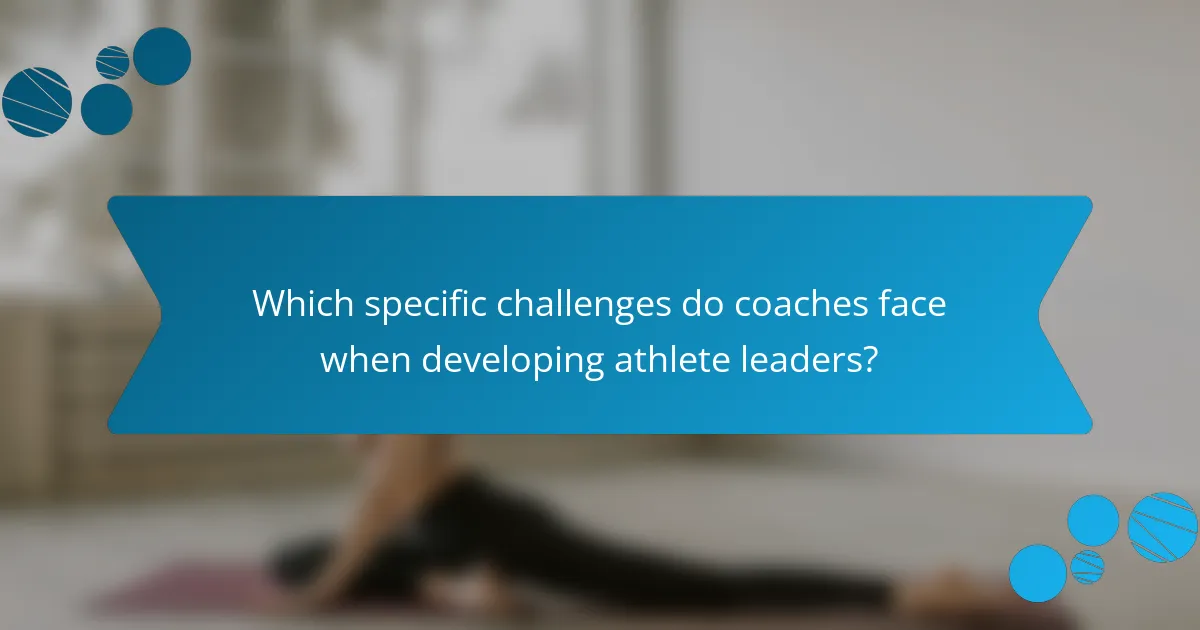Developing leadership skills in athletes is essential for enhancing team performance and individual growth. Effective coaching techniques include experiential learning, mentorship, and team-building exercises. Coaches can leverage team dynamics to foster communication and collaboration. Addressing challenges in communication and confidence is crucial for cultivating successful athlete leaders. Regular assessments and feedback mechanisms will ensure continuous leadership development.

What coaching techniques effectively enhance leadership skills in athletes?
Coaching techniques that effectively enhance leadership skills in athletes include experiential learning, mentorship, and team-building exercises. These methods foster decision-making, communication, and accountability.
Experiential learning involves athletes engaging in real-life scenarios, allowing them to practice leadership in a controlled environment. Mentorship pairs athletes with experienced leaders, providing guidance and support. Team-building exercises promote collaboration and trust, essential components of effective leadership.
Incorporating feedback mechanisms helps athletes reflect on their leadership style, enhancing self-awareness. Regular evaluation of leadership competencies ensures continuous development.
By integrating these techniques, coaches can cultivate strong leaders who excel both on and off the field.
How do communication strategies influence athlete leadership development?
Communication strategies significantly enhance athlete leadership development by fostering collaboration and clarity. Effective communication techniques encourage athletes to express themselves, build trust, and create a cohesive team environment. For example, regular feedback sessions and open discussions help athletes understand their roles and responsibilities, promoting accountability. Furthermore, incorporating storytelling in coaching can inspire athletes, making leadership concepts relatable and actionable. As a result, athletes develop essential leadership skills such as decision-making, conflict resolution, and motivation.
Which motivational methods foster leadership qualities in sports teams?
Coaching techniques that foster leadership qualities in sports teams include creating a supportive environment, promoting accountability, and encouraging open communication. These methods empower athletes to take initiative and develop decision-making skills.
1. Supportive environment: Coaches should create a safe space where athletes feel valued and respected. This builds confidence and encourages leadership.
2. Accountability: Assigning roles and responsibilities fosters a sense of ownership among team members. Athletes learn to hold themselves and each other accountable for their actions.
3. Open communication: Encouraging dialogue allows athletes to express their thoughts and ideas. This practice enhances collaboration and strengthens team dynamics.
4. Goal setting: Coaches should involve athletes in setting team goals. This inclusion promotes commitment and encourages leadership through shared vision.
5. Positive reinforcement: Recognizing and rewarding leadership behaviors motivates athletes to continue developing these skills. This approach reinforces a culture of leadership within the team.
What role does feedback play in building leadership skills among athletes?
Feedback is essential for building leadership skills among athletes as it fosters self-awareness and growth. Constructive feedback helps athletes understand their strengths and areas for improvement, enhancing their decision-making and communication skills. Regular feedback sessions create an environment of trust, encouraging athletes to take initiative and lead by example. This continuous loop of feedback cultivates resilience and adaptability, key traits for effective leadership in sports.

How can team dynamics be leveraged to cultivate leadership in athletes?
Team dynamics can be leveraged to cultivate leadership in athletes by fostering collaboration and communication. Coaches can implement group activities that emphasize teamwork, enabling athletes to take on leadership roles.
Encouraging peer feedback within teams enhances accountability and personal growth. This process helps athletes develop decision-making skills and confidence.
Regular team meetings can facilitate open discussions, allowing athletes to voice their ideas and concerns. This practice nurtures a supportive environment where leadership qualities can flourish.
Lastly, setting collective goals promotes a sense of ownership among athletes. When teams work towards shared objectives, individual leadership skills emerge naturally as athletes motivate and guide one another.
What are the benefits of peer-led initiatives in developing leadership?
Peer-led initiatives significantly enhance leadership development by fostering collaboration and shared learning. These initiatives promote accountability among participants, encouraging them to take ownership of their growth. They also create a supportive environment, where athletes can learn from each other’s experiences and perspectives. Furthermore, peer-led initiatives often lead to increased engagement, as individuals feel more invested in the process. This approach cultivates essential leadership skills, such as communication, empathy, and conflict resolution, which are vital for athletes both on and off the field.
How does collaboration contribute to leadership growth in sports?
Collaboration significantly enhances leadership growth in sports by fostering teamwork and communication skills. When athletes work together, they learn to share responsibilities and support one another, which builds trust and respect. This environment encourages them to develop decision-making abilities and conflict resolution skills, essential traits for effective leaders.
Moreover, collaborative training sessions allow athletes to receive diverse feedback, enhancing their adaptability. As they navigate challenges together, they cultivate resilience and a sense of accountability. These experiences not only prepare them for leadership roles within their teams but also equip them with essential life skills applicable beyond sports.

Which specific challenges do coaches face when developing athlete leaders?
Coaches face several specific challenges when developing athlete leaders. These include fostering effective communication skills, balancing authority with collaboration, and managing diverse personalities within a team.
Additionally, coaches often struggle with instilling confidence in athletes while navigating their varying levels of experience. Time constraints and the pressure to achieve immediate results can also hinder the development of leadership qualities.
Understanding these challenges is crucial for implementing effective coaching techniques that promote leadership skills in athletes.
What are common misconceptions about leadership training in sports?
Common misconceptions about leadership training in sports include the belief that it is solely about authority and not collaboration. Many think leadership skills cannot be developed, but they can be cultivated through specific coaching techniques. Another misconception is that only elite athletes require leadership training, while in reality, all athletes can benefit from these skills. Additionally, some believe that leadership is innate; however, it can be learned and improved over time. Lastly, there is a notion that leadership training is a one-time event, rather than an ongoing process that evolves with experience.
How can cultural differences impact leadership development in athletes?
Cultural differences significantly influence leadership development in athletes by shaping communication styles and decision-making processes. Coaches must adapt their techniques to respect diverse backgrounds. For instance, athletes from collectivist cultures may prioritize team harmony over individual recognition, impacting their leadership approach. Incorporating culturally relevant practices can enhance engagement and effectiveness in leadership training. Understanding these dynamics fosters a more inclusive environment, promoting growth and collaboration among athletes.

What unique attributes distinguish successful athlete leaders?
Successful athlete leaders are distinguished by their ability to inspire, communicate effectively, and demonstrate resilience. These unique attributes foster a positive team environment and enhance performance. Inspirational leaders motivate their teammates through vision and passion. Effective communication ensures clarity and builds trust. Resilience allows leaders to navigate challenges and setbacks, maintaining team morale. These qualities are essential for cultivating leadership skills in athletes through targeted coaching techniques.
How do emotional intelligence and resilience contribute to effective leadership?
Emotional intelligence and resilience significantly enhance effective leadership by fostering strong relationships and adaptability. Leaders with high emotional intelligence can understand and manage their own emotions while empathizing with others, leading to better team dynamics. Resilience allows leaders to navigate challenges and setbacks, maintaining focus and motivation. Together, these traits create an environment conducive to growth and collaboration, essential for developing leadership skills in athletes. Coaches can implement techniques that promote self-awareness, stress management, and emotional regulation, thereby cultivating these attributes in their athletes.
What rare qualities can set exceptional athlete leaders apart?
Exceptional athlete leaders stand out through their unique qualities like resilience, vision, and emotional intelligence. These traits foster team cohesion and inspire others. Resilience helps them overcome setbacks, while vision allows them to set strategic goals. Emotional intelligence enhances their ability to connect with teammates. Additionally, adaptability in various situations is a rare quality that distinguishes them from average leaders. This combination of attributes significantly impacts their effectiveness in coaching and leadership roles.

What are the most effective practices for measuring leadership growth in athletes?
Effective practices for measuring leadership growth in athletes include regular assessments, feedback loops, and goal setting. Coaches should implement structured evaluations, such as 360-degree feedback from peers and mentors, to gauge leadership skills. Additionally, tracking progress through specific, measurable goals enhances accountability. Incorporating self-reflection exercises allows athletes to assess their development. Lastly, fostering a supportive environment encourages open communication and collaboration, which are crucial for leadership growth.
How can coaches track leadership development progress over time?
Coaches can track leadership development progress by using structured assessments and feedback mechanisms. Regular evaluations help identify strengths and areas for improvement. Setting specific, measurable goals enhances accountability and provides clear benchmarks for progress.
Implementing tools like self-assessments, peer evaluations, and performance metrics allows for a comprehensive view of an athlete’s leadership journey. Additionally, maintaining consistent communication fosters an environment for growth and reflection.
Engaging athletes in discussions about their leadership experiences can yield insights into their development. This approach encourages self-awareness and active participation in their growth process.
By combining these techniques, coaches can effectively monitor and support the leadership development of their athletes over time.
What metrics are most indicative of successful leadership in sports?
Successful leadership in sports is indicated by metrics such as team performance, athlete development, and communication effectiveness. Key metrics include win-loss records, player retention rates, and feedback from athletes. These metrics reflect a coach’s ability to inspire, develop skills, and foster teamwork. Additionally, emotional intelligence and adaptability are unique attributes that enhance leadership effectiveness.
What expert tips can enhance leadership training for athletes?
To enhance leadership training for athletes, focus on practical coaching techniques that foster teamwork, communication, and decision-making. Encourage athletes to take on leadership roles during training sessions to build confidence and accountability.
Implement regular feedback sessions to discuss leadership behaviors and their impact on team dynamics. Use scenario-based training to simulate real-game situations, allowing athletes to practice decision-making under pressure.
Incorporate goal-setting exercises that emphasize collective objectives, reinforcing the importance of collaboration. Lastly, promote a growth mindset by celebrating both successes and learning opportunities, helping athletes develop resilience and adaptability in leadership roles.